This Technical Brief looks at what to do with large quantities of bulk wastes generated by natural disasters and conflict situations.
Background
Earthquakes, Tsunamis, major hurricanes and large-scale flooding can create large quantities waste, of building debris, rubble, sediments, organic waste and possibly even toxic wastes. Such waste poses not only a threat to public health, but can also seriously hinder relief programmes and the subsequent reconstruction efforts. The uncontrolled dumping of such wastes impacts negatively on public health and can have a detrimental impact on the environment. Incorrect waste disposal can lead to chemicals and heavy metals leaching into the groundwater, increased vermin presence, negative odour and visual impact. Large quantities of visible waste have a negative psychological impact on affected communities.
In spite of this, these wastes can provide a valuable resource to the reconstruction works through recycling and reuse to provide construction materials and income generating opportunities. The population can also play a positive role in planning and implementing environmental clean-up activities.
Example: Hurricane Ivan, Grenada
Hurricane Ivan, a Category 3 system with sustained winds of 115mph, demolished virtually all infrastructures in Grenada in September 2004. Assessment reports estimated around 90 % of homes have been destroyed or damaged. Infrastructures, such as electricity, water supply and access roads were also been severely damaged or affected.
The majority of Grenada’s population of approx. 100,000 people were severely affected by the hurricane. Poor and impoverished sectors, including low-income earners, were relocated to an estimated 85+ shelters across the island. Livelihoods were destroyed, and a large number of farmers were without access to their lands due to fallen trees. The government was overwhelmed by the scale of the disaster and unable to react quickly enough to the problems. The high quantities of debris in farming areas, in particular fallen trees, was also a factor preventing access to agricultural lands, thus affecting the ability of farming communities to re-establish their livelihoods.

Grenada
Options for Waste Management
The huge amount of debris generated by major events is likely to be a major problem early on into a relief effort. Large quantities of debris not only create access problems, but also pose a hazard both from a public health perspective and through increased risks of accidents. Planning a major waste management early on prevents waste streams becoming mixed, prevents double handling and is more cost-effective in the long-term.
Initial Needs Assessment
As a first step, including a waste management professional in initial assessment/implementation team is a pre-requisite for analysing and putting in to place a waste management strategy from the on-set of the emergency. Major stakeholders, such as Ministry of Health (MoH), Ministry of Works (MoW) and Waste Management Utilities (WMU) should also be included in the initial assessment phase from day one.
An initial assessment will highlight the volume of waste fractions to be dealt with, options for possible storage, transport needs, pre-treatment requirements and final disposal options. Typically, waste management options will include:
- Removing broken trees from hilly areas (to improve access and reduce risks)
- Demolition and debris removal to the main roads (clearing neighbourhoods)
- Removal and treatment of the metal waste (in particular zinc sheets)
- Removal and storage of the bulky waste factions (non metal building debris
- Removing large quantities of mud and sediments from main roads and residential areas.
- Identification and isolation of toxic waste sources.
A clearly written Terms of Reference (ToR) and the availability of experienced professionals is a pre-requisite to a successful needs assessment phase.
Example: Hurricane Ivan, Grenada
Hurricane Ivan generated a large amount of debris, needing to be dealt with; 13,760 ha of forest, 6,000 ha of trees along roads and in residential areas, and some 1.228.800 m³ of demolition waste that needed to be stored, disposed of or treated.
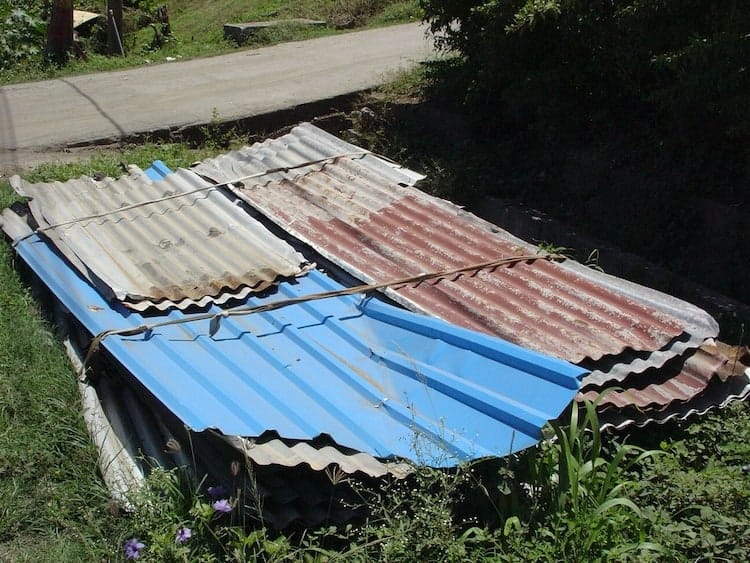
Grenada following Hurricane Ivan
Disposal Options Following Major Events
Typically, major landfills or dumpsites will be the main destination for large quantities of waste generated by a major natural disaster. However, in many developing countries, such sites are likely to be in a precarious condition prior to the disaster. Such sites lack the capacity to be able to store, or to dispose of the waste created by a major disaster.
Deploying a waste management professional early on enables the authorities to focus on the size and scale of the disaster, and to evaluate short-term solutions include setting up a number of temporary storage sites, where the various waste factions, sorted by type, can be stored on a temporary basis, pending further treatment or final disposal.
Example: Hurricane Ivan, Grenada
In Grenada, several sites were identified at different locations on the island, including: Perseverance Emergency Site (main landfill), Westerhill (St David’s), Telescope (St Andrews’s), Antoine River Estate (St Patrick’s), and Queen’s Park Stadium (St George’s). As part of the emergency response, Oxfam assisted GRENSWMA to build suitable fencing around both the Perseverance and the Telescope sites on their request. An operational manual, for operating the temporary sites, was also written.
Unfortunately, in spite of these operating procedures, the main landfill site at Perseverance still caught fire. The slow burning fire was started accidentally in February 2005, due to after hours dumping. GRENSWMA recognised their responsibility in not ensuring adequate site supervision.
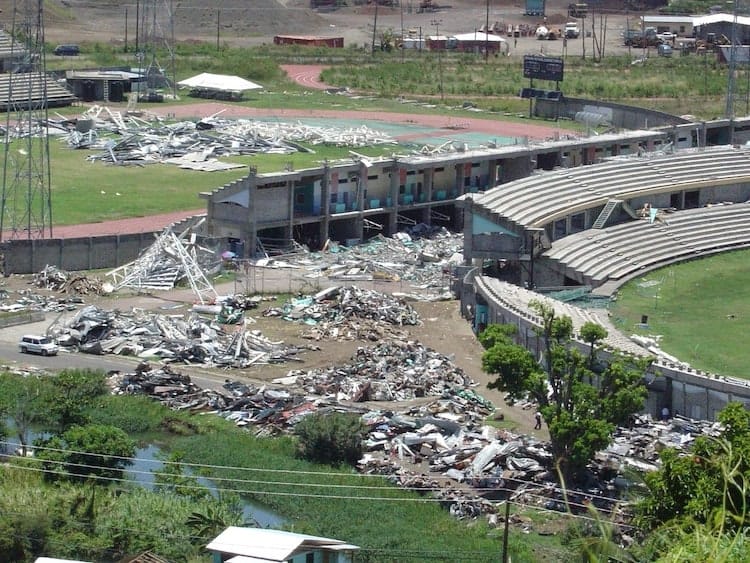
football stadium
Setting up Community Waste Schemes
In terms of collecting bulky waste, setting-up a community-based scheme, where specific areas are cleared in a systematic way, is the most efficient solution. Individual households can be made responsible for moving bulky waste from household plots to the roadside. Rented trucks can then be used to collect this waste from the roadside. Waste should be picked up and transported in its relevant fraction. Cash-for-Work (CFW) is an effective way to pay staff for loading the debris onto the trucks, with CFW staff being selected from the area being cleared. CFW is an effective means of regenerating livelihoods activities in the wake of a major disaster. Rivers and streams, along with other key public areas should also be cleared of debris by CFW teams.
Typically, the materials to be transported may include:
- Bulky construction waste (including asbestos)
- Corrugated iron roofing sheets
- Small trees/branches and other organic matter
- Mud and sediment loads (in event of flooding)
- Old furniture and damaged household items.
- Household rubbish mixed in with other wastes.
These waste fractions can be accumulated in piles by the roadside, with sorting into various waste factions taking place by the side of the road. In some areas where access is difficult, debris can be collected by small trucks and then transferred to larger trucks by cranes at a central location prior to removal to a temporary storage/disposal site. Early on, it may not be possible to remove large trees, due to their bulk. In this case, more focussed WM activities will be required to tackle the tree problem.
Community Mobilisation
Communities can be mobilised by loudspeaker cars passing through the target areas, prior to the waste management teams going into the area. In the event of vulnerable groups being identified (elderly, disabled and women headed households), CFW teams can be instructed to assist such people by collecting the debris from directly from their properties. Permission to undertake such measures must be obtained from the beneficiaries prior to the physical removal happening.
Community based activities are best coordinated by area coordinators, trained in the waste management process and with knowledge of the areas to be cleaned. CFW teams will in general be selected from the target communities, based on specific criteria. Typically, one supervisor may coordinate around 10 – 15 people. CFW teams should be rotated on a periodic basis to provide an opportunity for a number of different people to participate in the scheme. Typically, CFW teams may be employed for a maximum of two weeks in one area, before rotating to give others an opportunity.
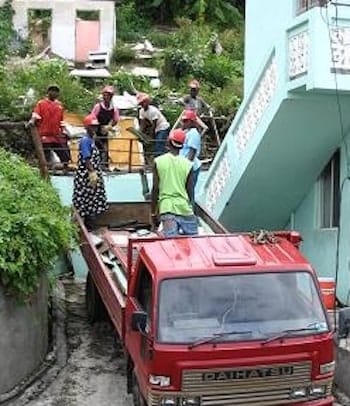
Grenada
The trucks required to transport the waste can be hired from small companies and individual owners, rather than from truck rental or construction companies. Good truck drivers, and good individual workers (supervisors) can be kept on as a means of raising the quality of the operation. Strict gender criterion for the selection of CFW teams should be adhered to, with at least 50 % of the CFW team being women.
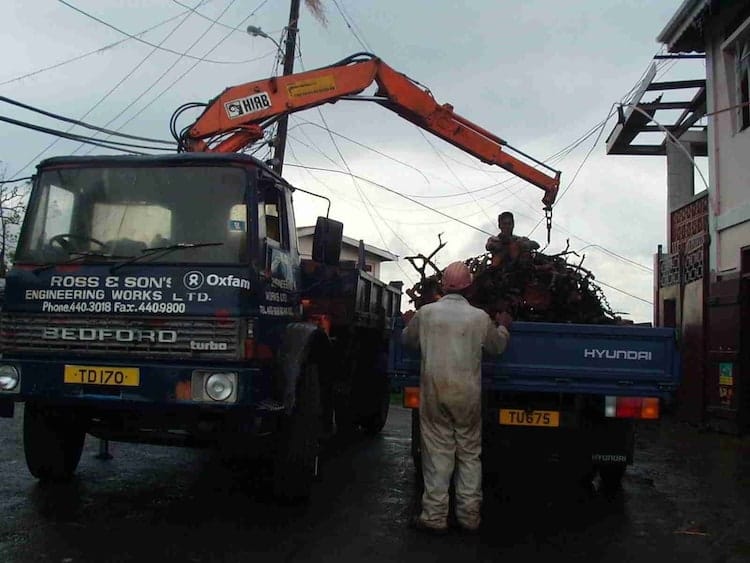
Hurricane Ivan
Setting up a Monitoring Scheme
Estimated volumes and weights of debris collected must be registered by team leaders on appropriate record sheets. These sheets should then be transmitted to the waste management engineer/coordinator. Figures can be compiled on a weekly basis and by team. Trucks discharging waste at official landfill/dumpsites should be weighed at a suitable official weighbridge, if possible. Weighbridges may be found at construction sites, government transport/customs facilities and at other bulk transport companies. This allows waste collection figures to be verified.
Post Collection Treatment
Various options are available for re-using and recycling waste fractions collected from environmental clean-up campaigns. Re-use/recycling options include:
- Baling corrugated iron-roofing sheets, for sale and export to an iron smelting plant. Baling may require the procurement of specialised baling machinery.
- Building rubble (concrete) can be crushed and used for building and road foundations. Steel rebar can be recycled. Specialised crushing machines are required to crush concrete, and care must to be exercised to ensure rubble does not contain asbestos waste.
- Building rubble (burnt bricks) can be recycled for re-use in reconstruction programmes or for re-sale to communities. Damaged bricks can be again used as hardcore.
- Timber from buildings can be recycled and re-used for reconstruction programmes or for re-sale.
- Small tress, branches and organic materials can be shredded into mulch and used as a soil conditioner. Mulch may have a commercial value. Again, specialised shredding machines will be required.
- Large trees can be cut into timber or reduced to smaller logs. Timber can be cured and used commercially, while logs can be used in traditional brick burning industries, by charcoal manufacturers or by other energy intensive industries such as sugar mills.
- Old tyres can be shredded and used to stabilise dirt tracks. Specialised tyre shredding machines will be required.
Coordination with Local Authorities
Coordination with the relevant local authority waste management operator is key to the success of any intervention. Operators must not only have to deal with their core business, household waste collection and disposal, as well as dealing with large quantities of waste created by the disaster. Developing a working relationship with waste operators helps focus minds on the scale of the problem, and in identifying phased solutions. This creates a dynamic for regular coordination meetings, which not only serve as information sharing sessions for government bodies, but also as a means of attracting other agencies and donors to work in a more co-ordinated way.
Example: GRENWASA, Grenada
GRENWASA is in charge of both collection and landfill site operation. OGB support allowed them to focus on the scale of the waste problem and to quickly restart their normal activities, i.e. the collection and disposal of household domestic waste. The rapid reestablishment of this service was a key factor in preventing outbreaks of vector borne diseases related to waste. OGB’s support in starting debris waste collection, temporary storage sites and improving operational practices was one of the major outcomes of the intervention. OGB’s assistance, in ensuring such activities happened in a timely and organised manner, was fundamental to the success of the overall clean-up effort. At a community level, the benefits of such activities were given as; a rapid reduction in the hazards caused by debris; improving access to rural and peri-urban areas; re-generating livelihoods (CFW); and contribution to the physiological well being of communities affected. Many of the CFW staff “found the activities fun” and GRENSWMA was complementary about OGB’s professionalism.
Example: GRENWASA, Grenada
One other major outcome of the intervention was the creation of a coordination body around waste management. OGB created a dynamic for regular coordination meetings, serving not only as information sharing sessions for relevant government bodies (GRENSWMA, MoH and Ministry of Works), but also attracted other agencies and donors to work in a more co-ordinated way. Meetings were regular, had agenda’s and were correctly minuted. It is interesting to note that GRENWSMA was able to obtain funding for equipment, recommended by the assessment, from one of the donors. The equipment obtained includes a metal baling machine, a wood chipper and a tyre shredder
Land Clearance Activities:
Land clearance activities are an extension of an environmental clean-up campaign, except that the activity is geared towards:
- Assisting small farmers to access their agricultural land;
- Providing CFW opportunities in some of the more marginalized communities.
The target is to provide farmers with access to their land by cutting up fallen trees on land and on access roads leading to farming land.
As a first step, chainsaws can be distributed to community groups to allow them to open up access roads to the area. After, groups can be established in a similar way to the environmental clean up campaigns, with small groups of 5 – 10 people from the affected area. Each group should have a “local” supervisor to ensure the affected community is fully integrated into activities. In general, CFW teams will be selected directly from the target areas, with the exception of the chain saw operators, who may move from one area to the next. In general, the chainsaw operators will have received training in both the equipments use and it’s maintenance. Again, the role of women in WM activities will be crucial to the success of the campaigns.
Opportunities to commercialise any wood cut should be investigated. Burning should be avoided wherever possible. Chipping the wood using a mobile wood-chipping machine is a more appropriate option. This protects the soil and is more effective in increasing fertility. Equipment such as chainsaws needs to be transferred between areas. Training the operators in the correct and safe use of such equipment is a pre-requisite to the safety of the programme.
Example: Grenada
The target was to provide 1,200 farmers with access to their land by cutting up fallen trees and by removing waste from access roads. CFW teams consisted of 5 – 6 workers led by a supervisor and equipped with chain saws and cutlasses. A maximum of 3-days was contributed to each farmer. An estimated 50% + of land clearance teams were women. The CFW team was responsible to cut up the fallen trees, leaving the plot holder to dispose of the remaining logs. In such a way, it was possible to complete the work on each plot in 1 – 2 hours.
Unfortunately, the logs appear to have been burned, rather than being used more productively. Over a period of 4-months, 565 farmers and their families were directly assisted. The activity assisted mainly small-scale nutmeg farmers in St David’s Parish, no assistance was given to large-scale farmers. At the beginning, no strict selection criteria were used, but this was later modified to:
- Families on less than EC$ 300 per month
- Families with damaged houses
- Farmers with < 3 acres land
- No other relief aid received
Supervisors were selected from areas being cleared to ensure the worst affected farmers had access to the services provided. The number of farmers finally assisted was lower than planned due to the late arrival of chainsaws.
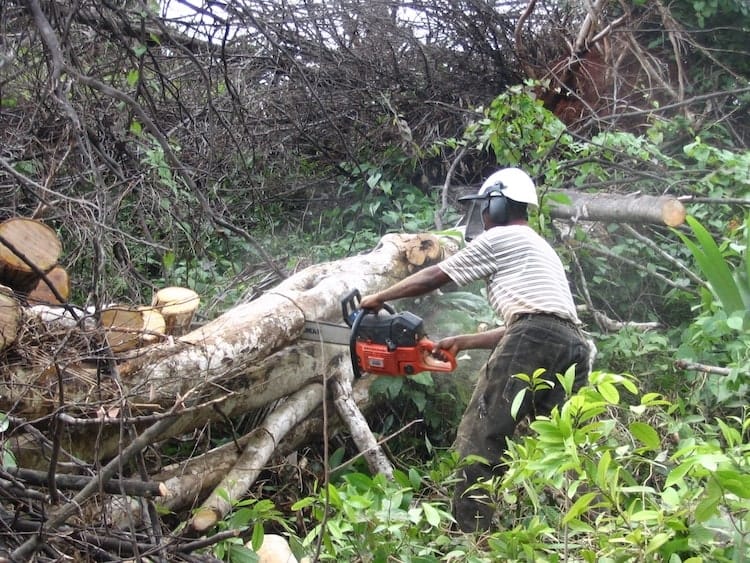
Opportunities to commercialise the wood cut on
individual farms were missed resulting in a large quantity
of logs being burnt unnecessarily)
Operational Considerations
Due to the remoteness of some agricultural areas, picking up CFW staff and transporting them to the land clearance sites requires vehicles, and results in the inefficiency of moving people around. Transport costs can be relatively high in rural areas, but there may be few alternatives. CFW activities may also require a considerable amount of cash to pay the CFW staff, obtaining and transferring such large quantities of cash may create security problems. Options may include using specialised cash transfer companies or requiring CFW staff to open a bank account, depending on the local context.
Example: Grenada
A typical budget for large-scale waste management activities includes:
Chainsaws 7,518
Truck hire 108,379
Waste disposal costs 7,216
Cash-for-Work 44,373
The above budget represents around 40 % of the overall programme budget. Core staff costs and the usual operating costs associated with transport and other logistics are not included above.
Additional Support / Expert Advice
Disaster Waste Recovery (DWR)
Website: www.disasterwaste.org
Martin Bjerregaard
tel: +44 7971 49 29 57
Helen Meekings
tel: +44 7919 447737
Annex I – Final Results from a Solid Waste Collection Program
| Week | Team 1 – David | Team 2 – Shadina | Team 3 – Bessie-Ann | Week Total | |||||||||||||||||||
| Period | Week | Costs (EC$) | Outputs (tons) | Costs (EC$) | Outputs (tons) | Costs (EC$) | Outputs (tons) | ||||||||||||||||
| Labour | Haulage | Total | Roof sheet | Board | Total | Labour | Haulage | Total | Roof sheet | Board | Total | Labour | Haulage | Total | Roof sheet | Board | Total | ||||||
| 27.9-1.10 | 1 | 28.0 | 3.2 | 31.2 | 31.2 | ||||||||||||||||||
| 4.10-8.10 | 2 | 28.0 | 3.2 | 31.2 | 31.2 | ||||||||||||||||||
| 11.10-15.10 | 3 | 28.0 | 3.2 | 31.2 | 31.2 | ||||||||||||||||||
| 18.10-22.10 | 4 | 43.4 | 1.6 | 45.0 | 45.0 | ||||||||||||||||||
| 25.10-29.10 | 5 | 28.0 | 5.6 | 33.6 | 33.6 | ||||||||||||||||||
| 1.11-5.11 | 6 | 22.1 | 38.8 | 35.2 | 74.0 | 96.1 | |||||||||||||||||
| 8.11-12.11 | 7 | 22.6 | 57.9 | 11.5 | 69.4 | 92.0 | |||||||||||||||||
| 15.11-19.11 | 8 | 29.0 | 43.3 | 29.1 | 72.4 | 101.4 | |||||||||||||||||
| 22.11-26.11 | 9 | 9,152 | 9,600 | 18,752 | 26.2 | 5,740 | 6,000 | 11,740 | 26.0 | 7,612 | 24,000 | 31,612 | 70.6 | 17.7 | 88.3 | 140.5 | |||||||
| 29.11-3.12 | 10 | 11,076 | 12,000 | 23,076 | 42.0 | 8,058 | 9,000 | 17,058 | 22.3 | 12.0 | 34.3 | 9,172 | 24,000 | 33,172 | 64.0 | 61.4 | 125.3 | 201.6 | |||||
| 6.12-10.12 | 11 | 8,704 | 9,000 | 17,704 | 18.6 | 16.6 | 35.2 | 5,844 | 7,000 | 12,844 | 29.7 | 10.9 | 40.5 | 9,588 | 10,650 | 20,238 | 58.9 | 46.1 | 105.0 | 180.8 | |||
| 13.12-17.12 | 12 | 9,412 | 9,000 | 18,412 | 20.0 | 25.6 | 45.5 | 4,628 | 18,550 | 23,178 | 51.4 | 5.4 | 56.8 | 10,504 | 11,250 | 21,754 | 57.8 | 35.1 | 92.9 | 195.2 | |||
| 20.12-22.12 | 13 | 5,148 | 5,400 | 10,548 | 14.5 | 8.8 | 23.3 | 3,120 | 10,950 | 14,070 | 21.0 | 4.7 | 25.7 | 6,188 | 5,400 | 11,588 | 22.9 | 18.8 | 41.8 | 90.8 | |||
| 28.12-31.12 | 14 | 6,812 | 7,200 | 14,012 | 46.6 | 15.0 | 61.6 | 3,640 | 15,200 | 18,840 | 19.8 | 22.7 | 42.5 | 8,840 | 7,200 | 16,040 | 38.5 | 14.8 | 53.2 | 157.3 | |||
| 3.1-7.1.05 | 15 | 6,550 | 6,550 | 13,100 | 35.3 | 2.4 | 37.7 | 4,992 | 7,200 | 12,192 | 18.0 | 16.4 | 34.4 | 6,240 | 6,750 | 12,990 | 37.3 | 3.1 | 40.4 | 112.5 | |||
| 10.1-14.1 | 16 | 5,512 | 6,550 | 12,062 | 34.8 | 13.3 | 48.0 | 4,992 | 4,500 | 9,492 | 8.1 | 14.0 | 22.1 | 6,344 | 6,750 | 13,094 | 31.8 | 3.5 | 35.3 | 105.4 | |||
| 17.1-21.1 | 17 | 5,460 | 5,650 | 11,110 | 20.3 | 7.7 | 28.0 | 5,044 | 6,750 | 11,794 | 19.3 | 22.9 | 42.2 | 5,466 | 6,750 | 12,216 | 33.7 | 8.9 | 42.5 | 112.7 | |||
| 24.1-26.1 | 18 | 1,560 | 2,850 | 4,410 | 10.4 | 1.2 | 11.6 | 1,404 | 2,700 | 4,104 | 13.2 | 2.3 | 15.6 | 1,560 | 2,700 | 4,260 | 13.2 | 0.6 | 13.9 | 41.0 | |||
| Total | 69,386 | 73,800 | 143,186 | 200 | 91 | 359.2 | 47,462 | 87,850 | 135,312 | 203 | 111 | 413.8 | 71,514 | 105,450 | 176,964 | 724 | 303 | 1,026.6 | 1,799.6 | ||||
| Grand total | 1,799.6 | Tons | |||||||||||||||||||||
